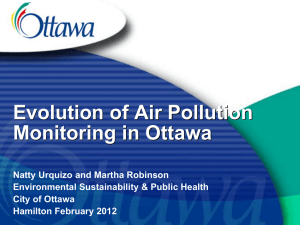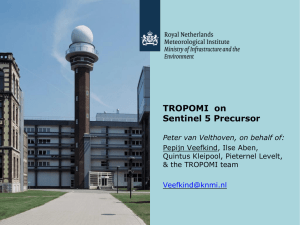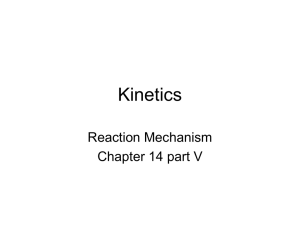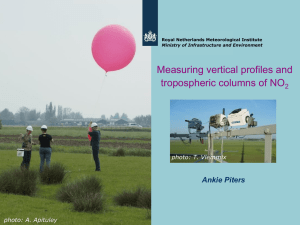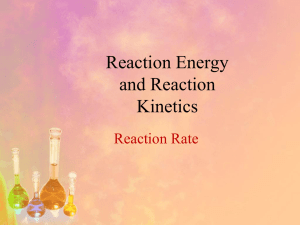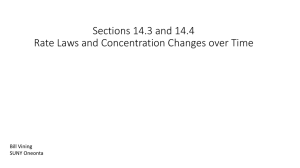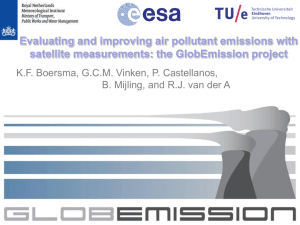Document
advertisement
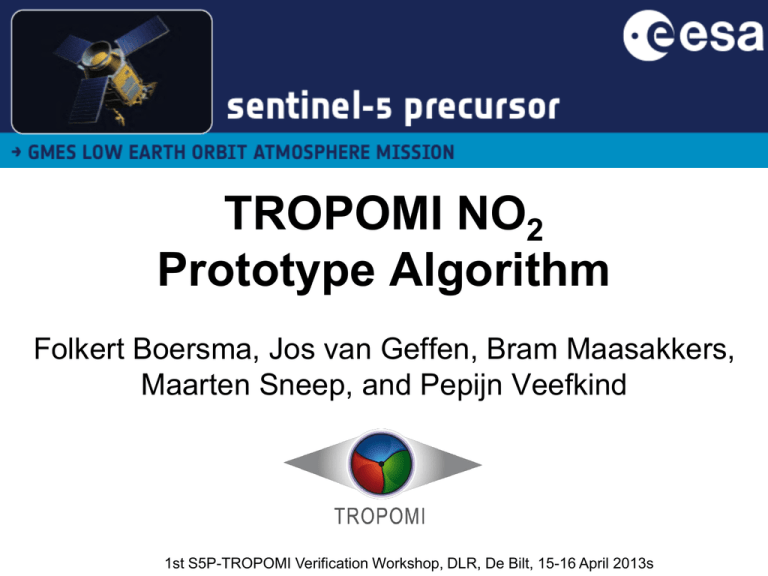
TROPOMI NO2 Prototype Algorithm Folkert Boersma, Jos van Geffen, Bram Maasakkers, Maarten Sneep, and Pepijn Veefkind 1st S5P-TROPOMI Verification Workshop, DLR, De Bilt, 15-16 April 2013s Algorithm overview 3-step approach (1) DOAS spectral fitting to obtain NO2 slant column densities (SCDs) (2) Separation of stratospheric contribution to the SCD by data assimilation in TM5 (3) Converting the tropospheric and stratospheric SCDs into vertical columns through air mass factors (AMFs) (1) Spectral fitting – DOAS Non-linear least-squares fitting of modeled spectrum to observed reflectance spectrum Wavelength calibration of lv1 radiance spectra prior to and separate of spectral fit Baseline retrieval settings: • 415 - 465 nm window • NO2, O3, H2O, & Ring reference spectra fitted • 5th order polynomial for broadband effects (1) Spectroscopic reference data NO2: Vandaele et al. [1998] O3: Brion et al. [1998] or Serdyuchenko et al. [2012] H2O: from HITRAN Ring: TBD (for OMI synthetic from De Haan) Hi-res spectra convolved with TROPOMI slit function input to spectral fit Temperature dependency NO2 cross section to be corrected for in later steps (need T, NO2 profile) (1) Spectral fitting Find Ysim(λ) that minimizes chi-squared merit: Probable fitting function: (2) Stratospheric contribution Assimilation of TROPOMI slant columns in the 3-D TM5 chemistry transport model (1° × 1°) Purpose is to update model state to be in close agreement with TROPOMI measurements Kalman Filter approach Adjustment of O-F model state Realistic model (P) & observation error estimates (R) required Strat. SCD (2) Stratospheric contribution Rii = σo2 with TM5 troposheric slant column TM5 stratospheric slant column A >> B reflecting larger uncertainty in tropospheric contribution to the error Assimilation updates: NO, NO2, NO3, N2O5, HNO4 Lifetime NOy: ~weeks info from TROPOMI stored over long periods (3) Air mass factor approach Decouple total AMF in altitude-dependent air mass factors and vertical NO2 profile Independent pixel approximation to account for (partially) cloudy scenes ml (¶N s ¶xa,l) calculated with DAK v3.2 and stored in LUT (3) Air mass factor approach ml calculated as a function of forward model parameters (LUT): • Solar zenith angle • Viewing zenith angle • Relative azimuth angle • Lambertian surface albedo • Surface pressure (3) A priori data to be used • • • • Solar zenith angle: TROPOMI (observed) Viewing zenith angle: TROPOMI Relative azimuth angle: TROPOMI Lambertian albedo: Monthly climatology MERIS (442 nm 0.25°x0.25°) • Surface pressure: Daily TM5 (1°×1°) & DEM_3KM • A priori NO2 profile: Daily TM5 (1°×1°) Fig B1, OMI stratospheric VCDs compared to GOME2 and SCIAMACHY values over the Pacific stratospheric NO2 columns measured by different instruments MI retrieves higher values than other satellite instruments (Fig B1) sed instruments. This difference in NO2 values is markedly higher pected due to the difference in measurement time. have now coupled our new version 3 retrieval to the TM5 global 3D CTM, which provides a priori profiles with a 1°×1° resolution. As suggested previously by Boersma et al. (2007) and demonstrated by Heckel et al. (2011), the better resolved a priori profile shapes lead to a better understanding of pollution gradients observed from space. Figure C1 shows the difference between modeled tropospheric NO2 columns of TM5 at 3°×2° (left) and 1°×1° (right). Figure C2 shows the difference between OMI tropospheric NO2 columns retrieved with TM5 at 3°×2° and 1°×1°. c E wavelength calibration of the OMI lv1b data reduces the retrieved mn density (SCD) by about 13% and the root-mean-square (RMS) of about 20%. The RMS can be further reduced by changing the OMI from the current 405-465 nm to 415-465 nm (Fig B2), which also D. Combining the two changes reduces the SCD over the Pacific 23% and the RMS by about 25%. A priori NO2↑ ► Lower tropospheric AMF↓ ► Retrieved NO2 ↑ Fig B2, OMI SCD and accompanying RMS using the improved calibration, as a function of the wavelength window used for the NO2 fit Fig C2, Tropospheric NO2 OMI columns retrieved with TM5 at 1°×1° - retrieved with TM5 at 3°×2° over Europe for 3-8 October 2004 TM5 cy3 with full chemistry 1° x 1° on one PC with 16 GB work memory 1 day takes ±75 minutes on 2 processors [B v t [H lo [B Q N (3) A priori data to be used • Snow/ice cover: ECMWF, NISE, … • Cloud radiance fraction w TROPOMI FRESCO v6 (observed) Consistent approach & a priori information with TROPOMI NO2: • Lambertian surface • Independent pixel appr. • ECMWF, NISE snow/ice • DEM_3KM terrain height Challenges (1) Spectral fitting: • Different fit windows, functions, and ref. spectra • O2-O2 • T-correction on slant columns or through AMF? • Raman scattering in water • Liquid water absorption • Sand signature? Challenges (2) Stratospheric correction: • Difficult to evaluate without real data • Strongly associated with accuracy spectral fitting and assumptions therein • Relies on (model) assumptions of tropospheric NO2 over reference/unpolluted region(s) Challenges (3) Air mass factor: •Cloud correction (IPA) or just cloud filtering? •Lambertian reflector model for terrain & clouds •Choice of RTM – polarization, sphericity •Inclusion of background aerosols vs. effective scattering … •Risk that AMF verification comes down to comparing a priori input data sets (albedo, terrain height, a priori NO2, …) Verification needs Distinguish avoidable from unavoidable differences Avoidable: • Spectral fitting (synthetic spectra) • Altitude-dependent AMFs (synthetic spectra) • Sensitivity (AMF) to a priori data Verification needs Distinguish avoidable from unavoidable differences Unavoidable (related to retrieval philosophy) • Choice for stratospheric separation • Choice for albedo dataset, terrain height, BRDF • Correcting vs. filtering for residual clouds • Choice for including background aerosol correction • Choice for source of NO2 profiles Verification needs Success criteria hard to define for NO2 final products Proposal for separate criteria: (1) Accuracy and precision of spectral fit (2) Minimum number of negative tropospheric slant columns (3) Quantitative agreement on avoidable differences (altitude-dependent AMFs, sensitivity to a priori data)

